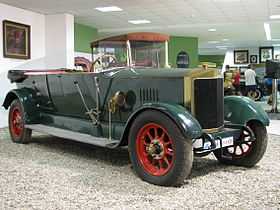NW S
| Nesselsdorfer Wagenbau-Fabriks-Gesellschaft Type S4 (18/24, 16/20) Type S4 (20/30) | |
|---|---|
 | |
| Overview | |
| Manufacturer |
Nesselsdorfer Wagenbau-Fabriks-Gesellschaft A.G. today Tatra, a.s. |
| Production |
1906 - 1912 S4 (18/24, 16/20) 1913 - 1917 S4 (20/30) 62 produced |
| Assembly | Kopřivnice, Moravia |
| Body and chassis | |
| Body style | diverse four- or six-seaters |
| Layout | Front-engine, rear-wheel-drive layout |
| Powertrain | |
| Engine |
3,306 cc (201.7 cu in) liquid-cooled vertical four-cylinder 14,7kW (20 HP) S4 (18/24, 16/20) 14,7kW - 22kW (20–30 HP) S4 (20/30) |
| Transmission | four speeds (+reverse) |
| Dimensions | |
| Wheelbase |
2,900 mm (114.2 in); 3,000 mm (118.1 in); 3,100 mm (122.0 in); 3,400 mm (133.9 in) S4 (18/24, 16/20) 3,100 mm (122.0 in) S4 (20/30) |
| Curb weight |
1,172 kg (2,584 lb) - 1,290 kg (2,840 lb) depending on carrossery [1] |
| Chronology | |
| Successor | NW T |
| Nesselsdorfer Wagenbau-Fabriks-Gesellschaft Type S6 | |
|---|---|
| Overview | |
| Manufacturer |
Nesselsdorfer Wagenbau-Fabriks-Gesellschaft A.G. today Tatra, a.s. |
| Production |
1912 - 1915 12 produced |
| Assembly | Kopřivnice, Moravia |
| Designer | Hans Ledwinka |
| Body and chassis | |
| Body style | diverse four or six seaters |
| Layout | Front-engine, rear-wheel-drive layout |
| Powertrain | |
| Engine |
4,959 cc (302.6 cu in) liquid-cooled vertical six-cylinder 29,6kW- 36,8kW (40-50 HP) |
| Transmission | four speeds (+reverse) |
| Dimensions | |
| Wheelbase | 3,450 mm (135.8 in) |
| Curb weight |
1,800 kg (4,000 lb) depending on version [1] |
| Chronology | |
| Successor | NW U |
The NW type S is a veteran automobile manufactured by Nesselsdorfer Wagenbau-Fabriks-Gesellschaft A.G. (NW, now known as Tatra).
Hans Ledwinka, who left the company in 1902, was hired back in 1905 (meanwhile he worked for company of Alexander Friedman in Vienna). Immediately he started working on a new car with modern and progressive design. Some of the new features included overhead valves, actuated by overhead camshaft (OHC), and hemispherical combustion chamber. The engine was mounted at three points, the engine block had large service access doors. The engine with the gearbox formed one massive unit, so-called monoblock.[1]
The gearbox itself was of a bell shape with only five gears. Two gears were ring type with teeth on the inside surface. Individual speeds were engaged by moving the gears radially. The rear axle was driven by a drive shaft in lieu of chains.[1]
The S 4 and S 6 with four-cylinder or six-cylinder engines were able to reach maximum speeds of 80 km/h and 100 km/h (50/62 mph). The total production of both models was 74 units.[1]
References
| ||||||||||||||||||